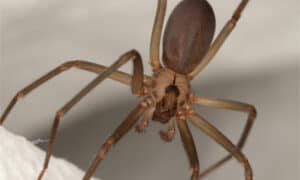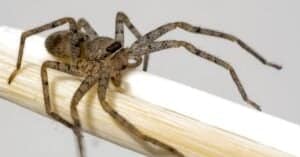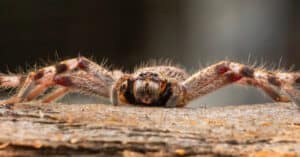While you’re walking around Chicago checking out the sights, lovely tunes, and the smell of the delicious deep-dish pizza, there is a smaller eight-legged community living their lives. Crawling around Chicago are some very diverse and strange spiders. Some are nocturnal, but many can be found in broad daylight on the sides of buildings or between trees lying low in their enormous orb-shaped webs.
As with all creatures, these arachnids are worth getting to know. Let’s journey into their world for a short while and learn what makes these spiders feared but quite amazing.
1. Brown Recluse (Loxosceles reclusa)
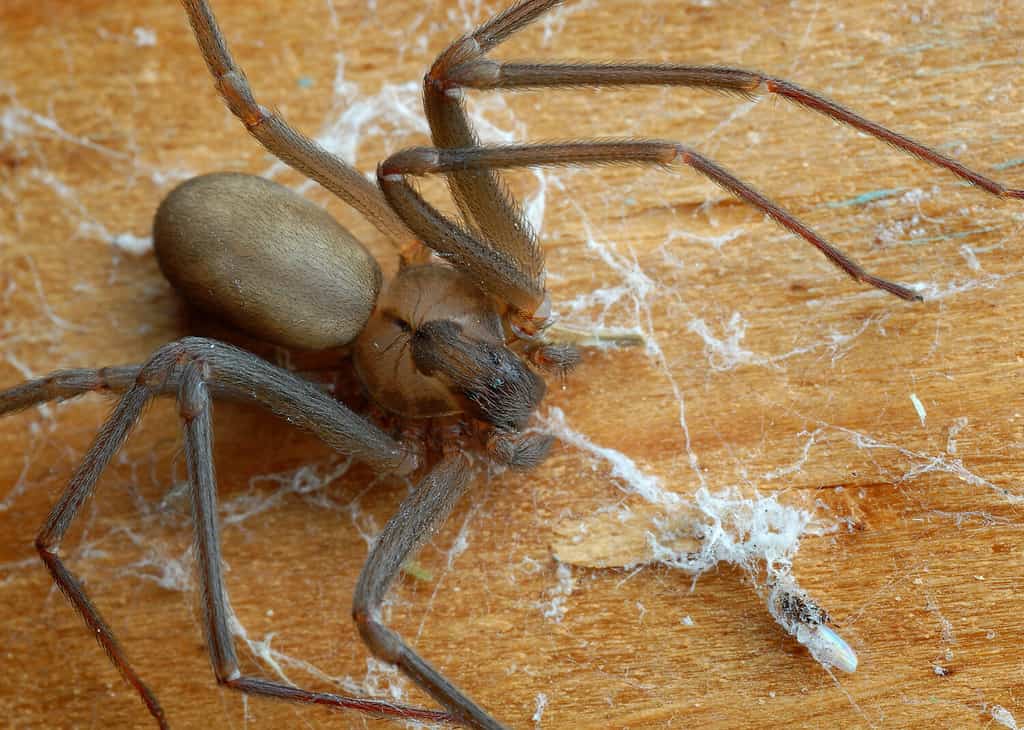
Brown recluse spiders have a clean violin shape on the front part of their body.
©Miles Boyer/Shutterstock.com
Appearance: This spider has solid brown legs with a violin shape on the cephalothorax up to the spider’s eyes. The violin’s neck points towards the back of the spider. The spider is round and light brown or beige. They only have six eyes as opposed to the eight that most spiders come equipped with.
Size: 1/4 – 1/2 inches long and a 1-inch leg span
Diet: As nocturnal hunters, the brown recluse eats what it can hunt and catch without a web. It also eats other spiders.
Habitat: They hide under boards, old wood piles, leaf litter, or natural debris. They can also be found in corners of outdoor buildings and ignored boxes. They are only located in Louisiana, Ohio, Texas, Alabama, Arkansas, Georgia, Mississippi, Nebraska, Illinois, Indiana, Iowa, Kansas, Kentucky, Missouri, Oklahoma, and Tennessee.
Behavior: They are nocturnal hunters and do not make webs to catch prey. These spiders hunt by sneaking up on their prey. They are also known to be cannibalistic with other spiders and their kind and eat dead insects.
Dangers: They are shy spiders and bite only as a last resort.
2. Northern Black Widow (Latrodectus various)
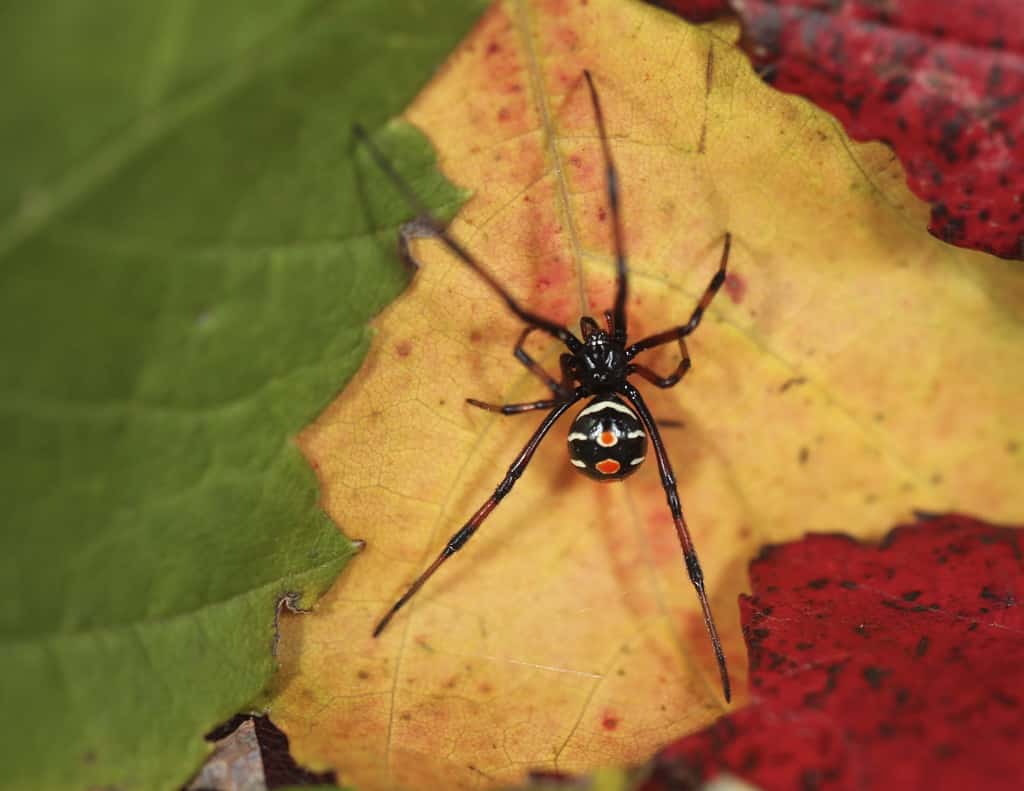
Northern black widow spiders sometimes hide amongst fallen leaves.
©iStock.com/NajaShots
Appearance: A black pea-sized spider with two red spots on the underside of its abdomen. This is referred to as a broken hourglass and is sometimes missing the middle section, and other times it appears just as two red dots. The males have brown legs and have sets of white bands along each side of their abdomen. Juveniles of both sexes can have white banding.
Size: Females are .31 – .5 inches long with a leg span of 1 – 1.37 inches long. The males are .11 – .4 inches long with a leg span of .51 inches.
Diet: Small flies, gnats, tiny crickets, mosquitos, and other tiny flying species.
Habitat: Manmade structures like houses, garages, attics, walls, cabinets, wood piles, playhouses, boxes, and outdoor toy bins. They are very timid and stay hidden almost always.
Behavior: Because of their timid disposition, the spiders stay hidden in crevices or small undisturbed spaces most of the time. They make small, sloppy cobweb spiderwebs for catching small insects.
Dangers: There is less than 1% mortality of people bitten, and those are generally small children. The female spider releases a neurotoxic venom when she bites. The amount of toxin varies depending on when she last used it. The venom of a black widow is 15 times stronger than rattlesnake venom. The bite causes severe pain, swelling, severe cramping, fever, nausea, sweating, and chills, just to name a few. However, even if a typical person doesn’t seek antivenom or medical attention, the bite typically goes away in a few days. The pain and other negative symptoms will last that long without antivenom if the spider releases a big load of venom in her bite.
3. False Widow (Steatoda triangulosa)
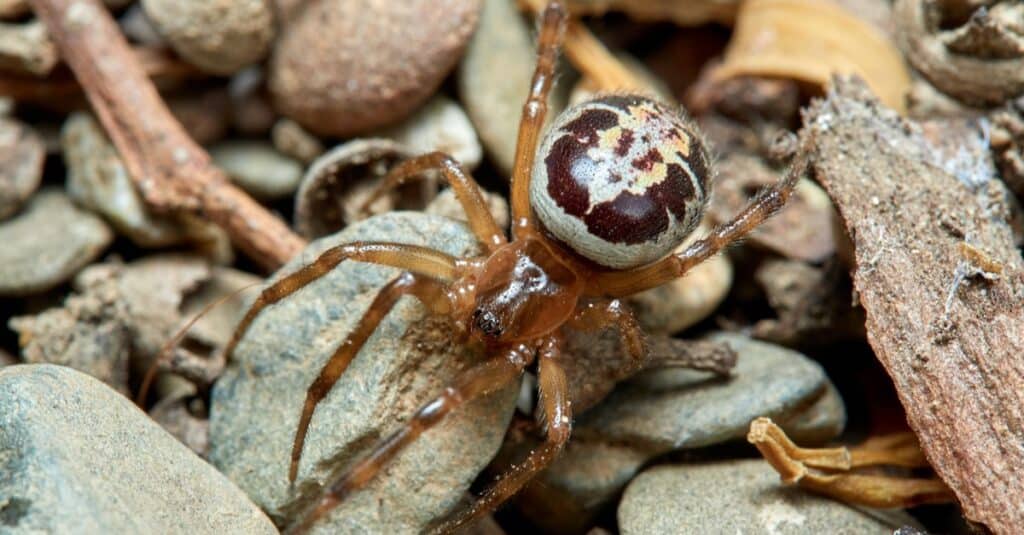
False widow spiders are small and delicate and would much rather hide than bite anyone who isn’t an insect.
©iStock.com/Macronatura.es
Appearance: They can vary in color but always have a paler decoration on their backs. All cobweb spiders have very delicate, tapered, long legs with small pea-sized or smaller bodies.
Size: They grow to be the size of a pea and have a maximum leg span of 1/2 inch.
Diet: Gnats, small flies, other small spiders, and whatever else flies into their small tucked-away webs.
Habitat: Dark corners, behind toilets, inside boxes in attics and garages, outside toy boxes, and any place that seems dusty and abandoned. They make messy “cobwebs” that look like they were also abandoned.
Behavior: The cobweb spider is shy and stays hidden for almost all of its life.
Dangers: As with all spiders, the false widow does have venom, but it is not dangerous unless the victim is allergic. The bite will not bring harm other than pain that will last for 1 – 12 hours but rarely lasts 24 hours. It is comparable to a wasp sting. They will run rather than bite unless they are trapped in clothing or are grabbed by accident.
4. Arrowhead Orbweaver (Verrucosa arenata)
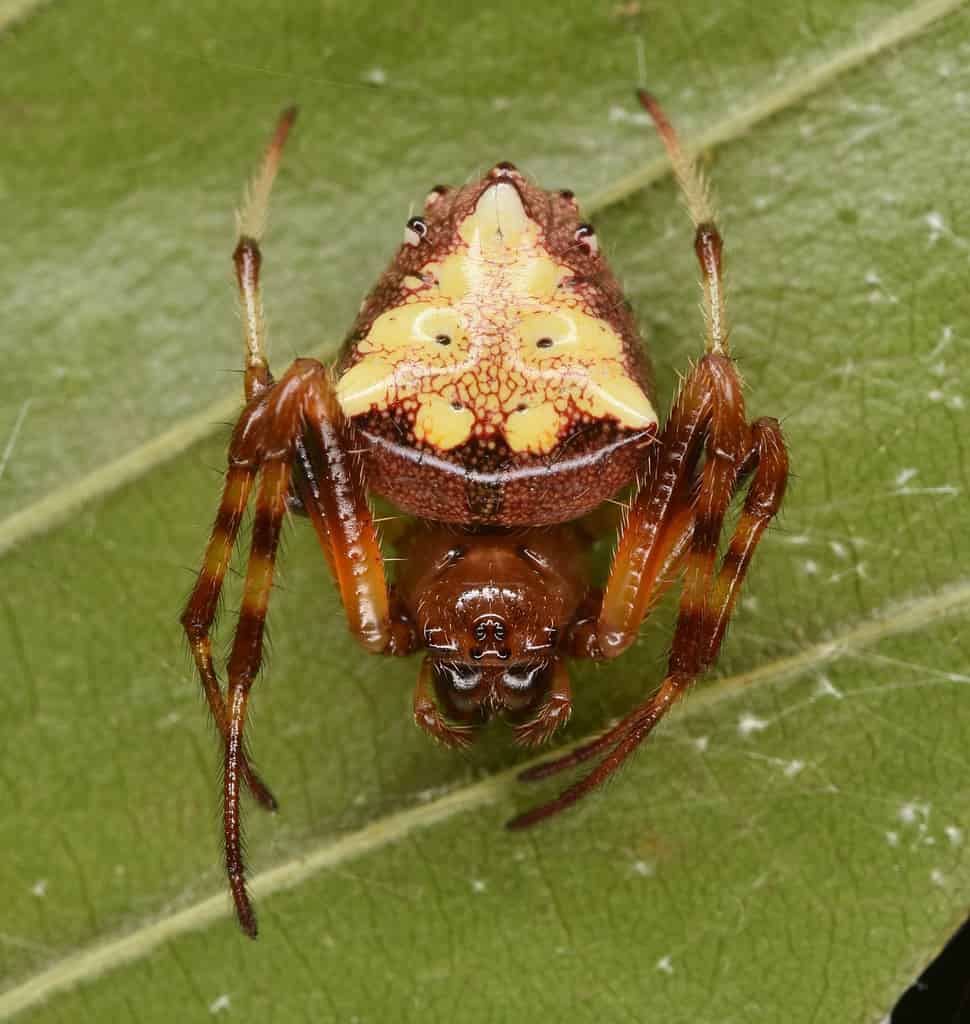
The beautiful triangle or arrowhead orb weaver can be seen in late summer.
©Christina Butler from Georgia, United States / CC BY 2.0 – License
Appearance: Triangular-shaped abdomens with a white, pink, or yellow arrowhead or triangle on their back. The rest of the spider is brownish-grey with stripes along its legs.
Size: Females are 1/4 inch long with a 3/4 inch leg span, while the males are much smaller.
Diet: Flies, moths, butterflies, and other flying insects.
Habitat: Gardens, shrubs, marshlands, wetlands, wooded areas
Behavior: These spiders have what looks to be icing on their backs with a zig-zag design to make them appear larger to predators. They build new webs daily.
5. Bold Jumping Spider (Phidippus Audax)
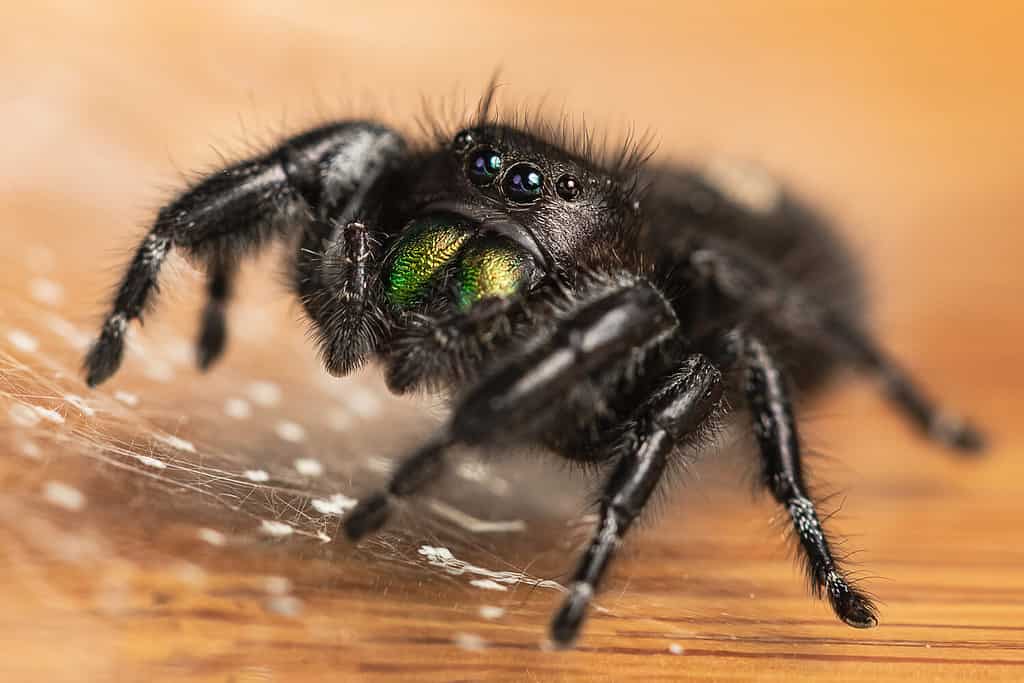
When mature, male jumping spiders have large, brightly colored chelicerae and what looks like boxing gloves on their pedipalps.
©Gill Thompson/Shutterstock.com
Appearance: Black with white markings on their backs. Sometimes with spiders who have recessive genes, the white may be orange or beige.
Size: 1/2 inch, which is slightly smaller than regal jumping spiders (Phidippus regius).
Diet: Flies, crickets, gnats, bees, and anything else that they can catch. These spiders catch prey by hunting, stalking them with a big jump, and they grab and bite their meal. They sometimes catch prey four times their size!
Habitat: All jumping spiders make little hammocks that serve as a bed and as a place to molt. They lay their eggs nearby in a silk-enclosed ball. Since they are arboreal and like to walk on manmade objects like fences, houses, playhouses outside, and so forth. They love the sun, and on pleasant sunny days, they can be found on vehicles or walls in the sun.
Behavior: Jumping spiders are the only spider that seems to be curious about humans. They will often jump on an offered hand and look at your face with curiosity while tilting their heads like a dog does when it hears something it doesn’t understand.
Dangers: So much cuteness can be an overload.
6. Common House Spider (Parasteatoda tepidariorum)
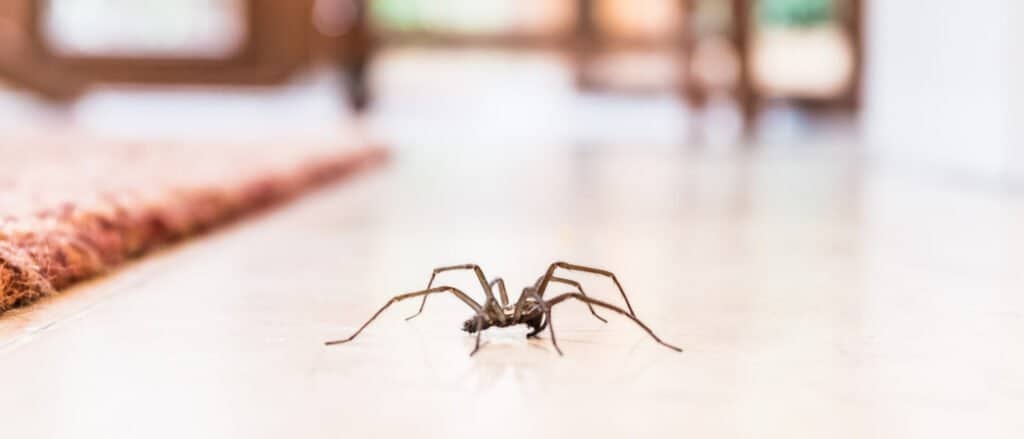
Common house spiders are frequently seen when the weather turns cold.
©Christine Bird/Shutterstock.com
Appearance: The little round spider has yellow and brown legs with stripes. Their body can vary in color from black to beige and has a white spot behind the tallest point.
Size: Females are 5 – 8 millimeters, and males are 4 millimeters.
Diet: Tiny insects, flies, small crickets, and other spiders.
Habitat: They make messy-looking webs that many people refer to as cobwebs. The spiders like to make their messy webs in corners of rooms or bathrooms and also tucked away boxes and other out-of-the-way items.
Behavior: These small spiders are still fearful of humans but live predominantly inside homes.
7. Broad-Faced Sac Spider (Trachelas Tranquillus)
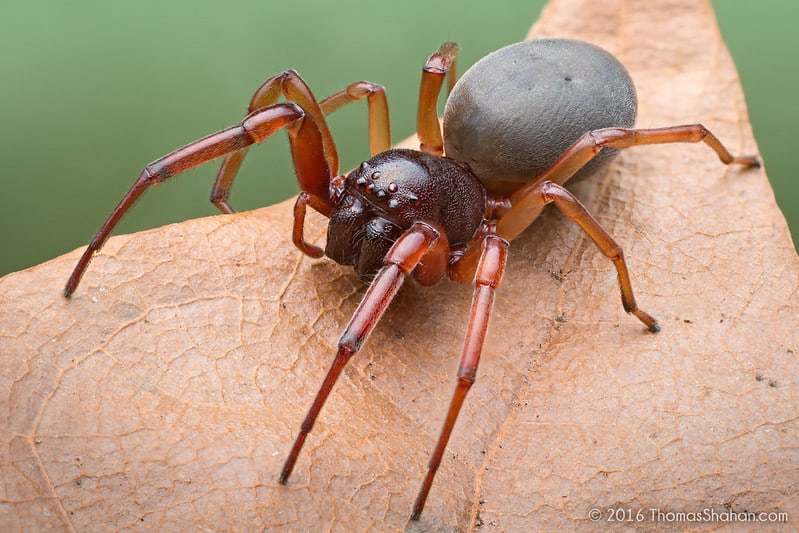
The broad-faced sac spider is a scavenger and will eat dead insects, which is not common for a spider.
©Thomas Shahan / flickr – License
Appearance: These spiders have a dark reddish-brown cephalothorax and an off-white abdomen. They look similar to the woodlouse spider but have eight eyes.
Size: Females are 1/3 inch long, and the males are 1/4 inch long.
Diet: Mites, dead insects, and dead spiders.
Habitat: They hide under rocks, wood, or in rolled-up leaves on the forest floor.
Behavior: Also called the bull-headed spider, hunts on the ground on its eight legs and feeds on dead insects, mites, and other spiders.
Dangers: This can be a very painful bite similar to a bee sting. The bite can become very infected in children.
8. Triangular Cobweb Spider (Steatoda triangulosa)
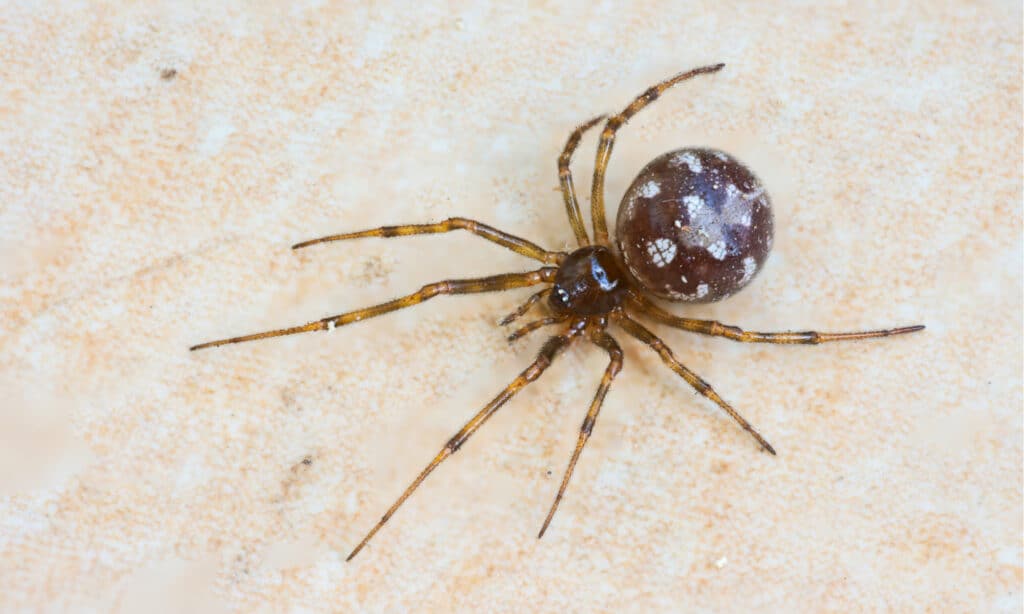
The triangular cobweb spider looks similar to its cousins, the black and false widows.
©Timelynx/Shutterstock.com
Appearance: Small, round pea-sized body with spindly amber and dark brown striped legs that taper to a point. Their name comes from the white triangular-shaped pattern on their reddish-brown to purplish-colored backs.
Size: 3 – 6 millimeters long
Diet: Small insects, flies, gnats, and anything else that gets caught in their messy webs.
Habitat: Dusty corners in homes, quiet spots in attics and garages. Also found in old boxes and other seldom-touched boxes, like hilday decoration boxes.
Behavior: Cobweb spiders are very shy, and though they enjoy living near humans, they do their best not to cross paths with one another.
9. Labyrinth Orbweaver (Metepeira labyrinthea)
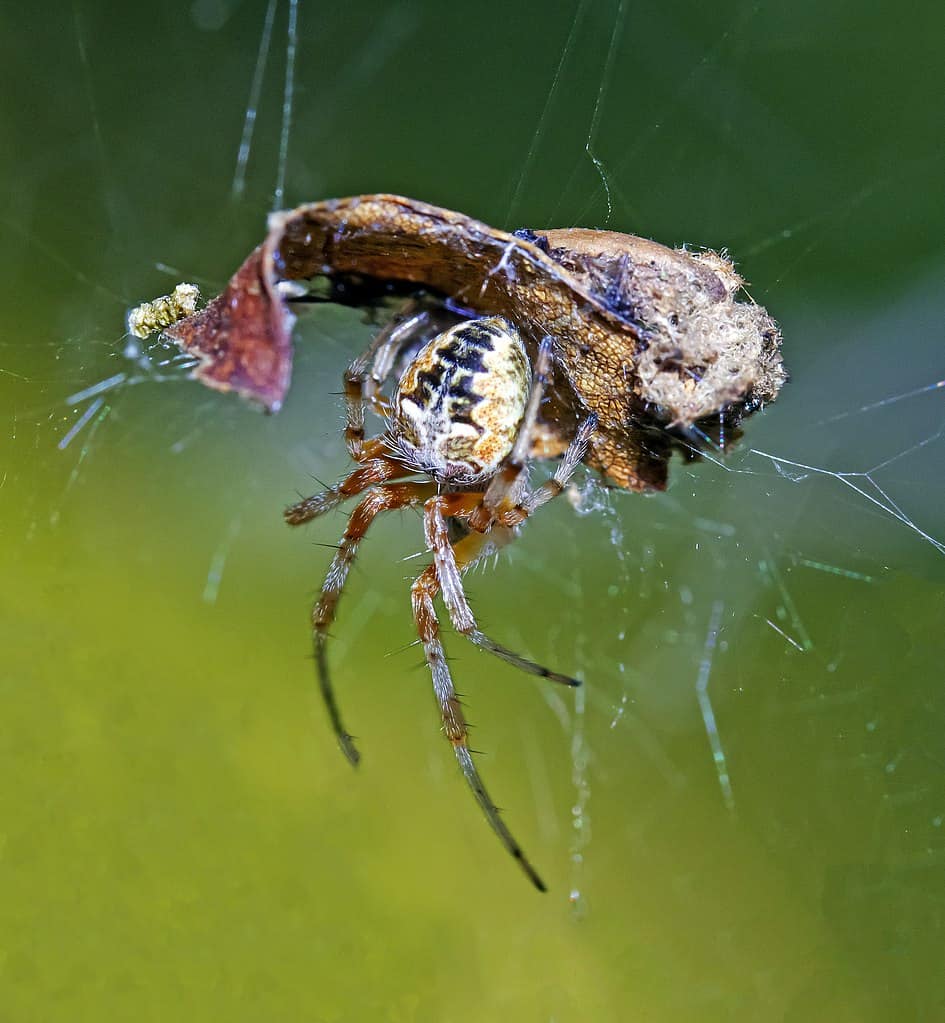
The labyrinth orb weaver builds a web consisting of both an incomplete orb and a tangled cobweb.
©WanderingMogwai / CC BY-SA 4.0, via Wikimedia Commons – License
Appearance: Pretty, golden to brown and beige-colored, oval-shaped orb weaver. It also has an intricately detailed white design on its back.
Size: Females are 5.3 millimeters, whereas males are roughly 3/4 of the females’ size.
Diet: Small prey insects, grasshoppers, crickets, flies and
Habitat: Between branches or bushes where they can make a wide web.
Behavior: Orbwevers are all very laidback and do their best to avoid humans.
10. Bowl and Doily Spider (Frontinella pyramitela)
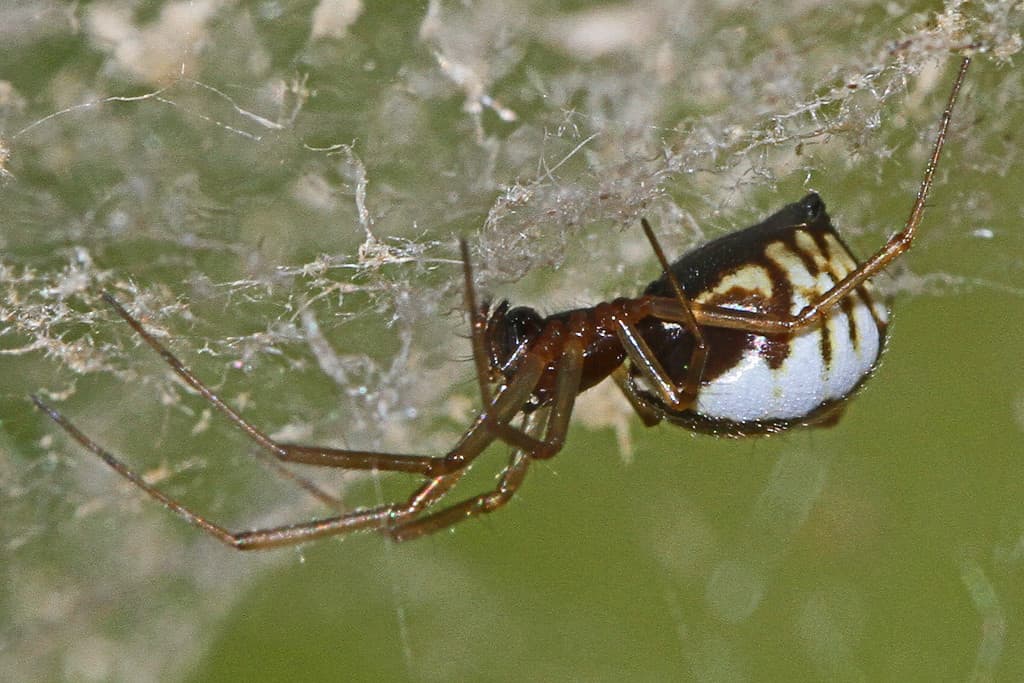
Bowl and doily spiders are related to black widows and other cobweb spiders.
©Judy Gallagher / CC BY 2.0 – License
Appearance: Small reddish-brown spiders with white zigzags on their sides.
Size: Both males and females are 1/8 inch long with a 1/2 inch leg span.
Diet: Small insects such as mosquitos and flies.
Habitat: The edges of fields and just outside forests.
Behavior: The spider belongs to the sheet weaver family and lies underneath its sheet-like web and waits for prey to touch the web, where it bites through and captures the insect.
11. Marbled Orbweaver (Araneus marmoreus)
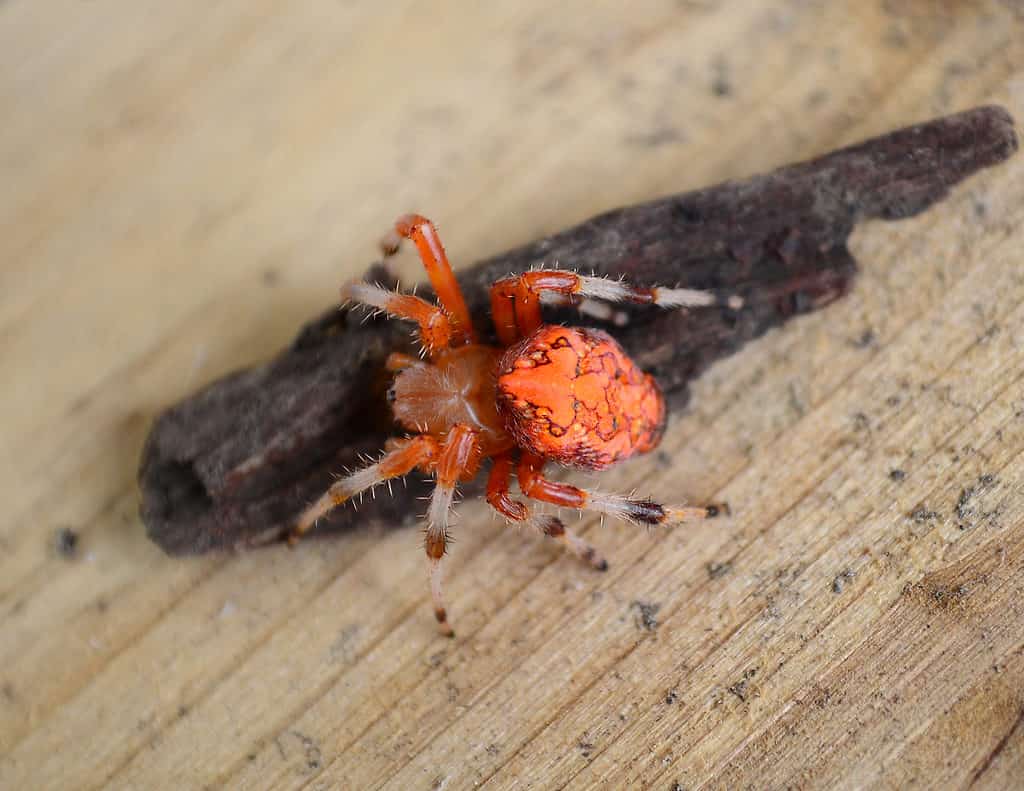
The bright orange Marbled
Orb Weaver
spider is called an orange spider or a pumpkin spider.
©iStock.com/earlydawnphotography
Appearance: This orb weaver can vary much in color from bright orange to yellow to beige. They have beautiful, intricate designs on their backs.
Size: 1/2 – 1 inch
Diet: Any insect or spider that happens to end up on their webs.
Habitat: They make large orb-shaped webs in weeds, bushes, or trees. It is generally in a moist environment or near a water supply.
Behavior: These easy-going spiders eat their webs in the very early morning, and then build a new web near sunrise. They prefer to make their large webs near water and sit in a silk hammock on the side of the web during the day. If there is danger, they fall to the ground and hide until the danger has passed.
12. Tan Jumping Spider (Platycryptus undatus)
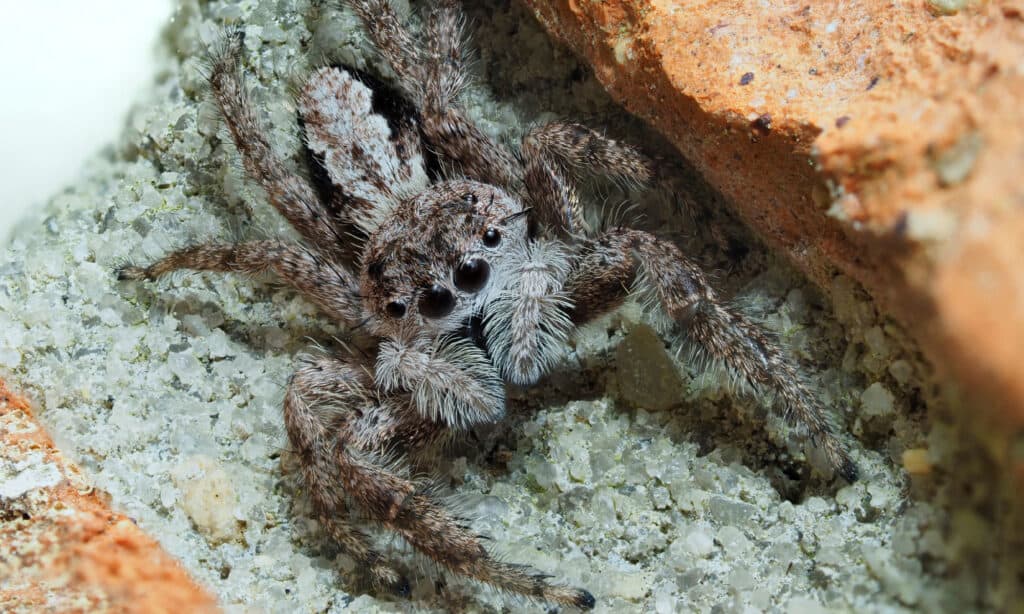
The tan jumping spider has keen eyesight and excellent jumping ability making them an excellent hunter.
©iStock.com/sdbower
Appearance: Small greyish spiders with tan and darker camouflaged markings on their body. They have brightly colored chelicerae and fluffy pedipalps, like all jumping spiders.
Size: Females are .39 – .51 inches long with a leg span of .5 inches, and the males are .33 – .37 inches long.
Diet: Crickets, moths, flies, occasionally fruit, and other small insects.
Habitat: Manmade structures, fences, trees, plants, and vehicles.
Behavior: Inquisitive and charming, but they are also vicious hunters by air and ground. They can jump over 10 times their size.
13. American Nursery Web Spider (Pisaurina mira)
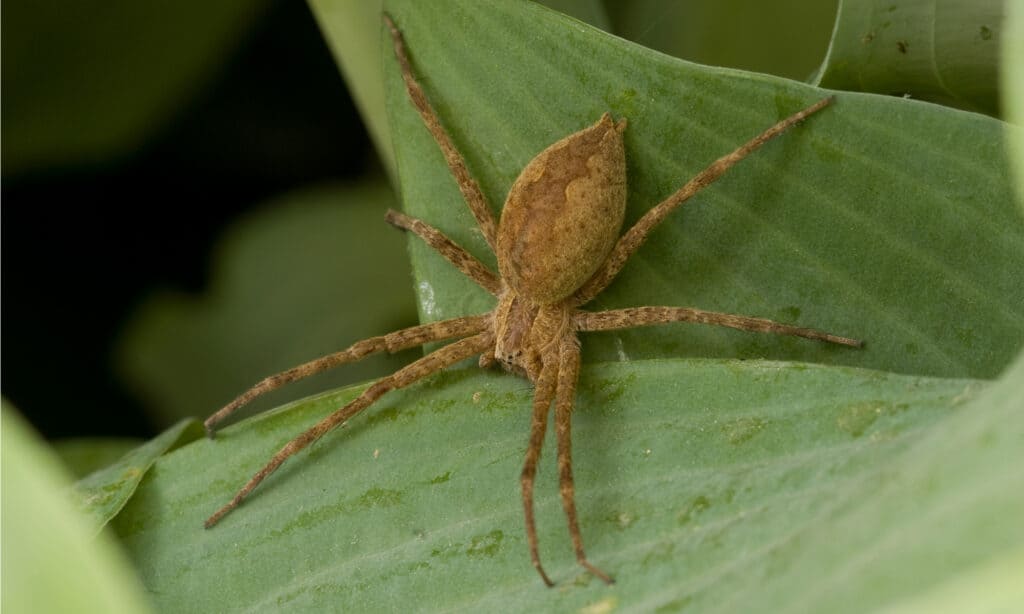
American nursery web spiders carry the egg sac until it is almost ready to hatch. Then they make a special sling-type web for the baby spiders to hatch in.
©SDeming/Shutterstock.com
Appearance: This spider has two front rows of eight eyes, which is different from most other spiders. These spiders can be light brown to tannish-grey. Some are even dark brown and have a broad dark stripe down the center of their body.
Size: Females are .49 – .59 inches long with a leg span of nearly 2 inches, while the males are .35 – .59 inches long
Diet: Water bugs, mosquitos, gnats, moths, and others.
Habitat: They prefer areas near river banks, docks, creeks, or other bodies of water and choose to build a small web in the plant life found along the banks.
Behavior: The nursery web spider gets its name because the female suspends her egg sac in a triangular web right before the spiderlings hatch. The mother spiders can defend their young until they molt into large enough spiders to be on their own.
14. Orchard Orbweaver (Leucauge venusta)
Appearance: These spiders are very similar to long-jawed orb weavers in appearance but are brilliantly colored in blue, green, red, orange, and yellow. The underside is silvery with black stripes, and it is more apparent in the males.
Size: Females are .25 – .30 inches long with a leg span of 2 inches, while males are .13 inches long with a leg span of 3/4 inches.
Diet: Tiny insects such as mosquitos, gnats, moths, and others.
Habitat: Apple orchards, woodlands, edges of forests, shrubs, and low-lying trees.
Behavior: They create large circular webs that are taken down and redone daily. Since the males have fangs, they can defend themselves after mating is finished.
15. Brilliant Jumping Spider (Phidippus clarus)
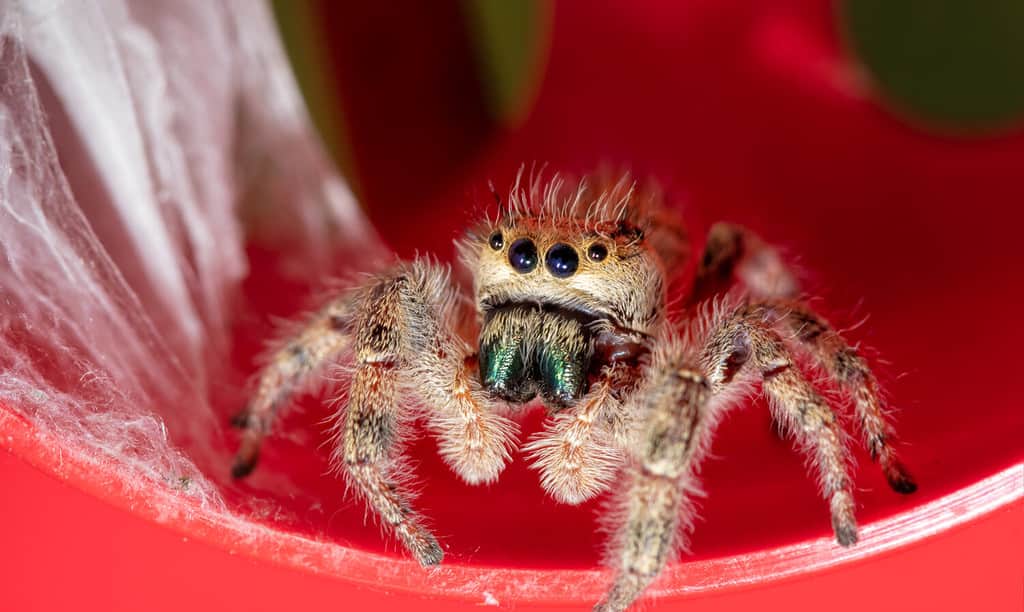
©Sari ONeal/Shutterstock.com
Brilliant jumping spiders, like this female, are adorable with their hairdos and huge eyes.
Appearance: The females are bronze to gold on the carapace, while the rest of their body can vary in color from tan, grey, brown, and orange. The males are mostly black with an iridescent sheen, a white band on the front, and a broad orange longitudinal down the center.
Size: The females are 1/2 an inch long with a 3/4 inch leg span. The males are 1/8 – 1/4 inch long.
Diet: They hunt by stalking and pouncing on their prey, which can be flies, crickets, worms, or other insects.
Habitat: They can be found in fields on tall grasses, on manmade structures and trees.
Behavior: These are curious spiders, like most other jumping spiders. They enjoy sunlight and may spend a lot of time in their hammocks.
16. American Grass Spider (Agelenopsis pennsylvanica)
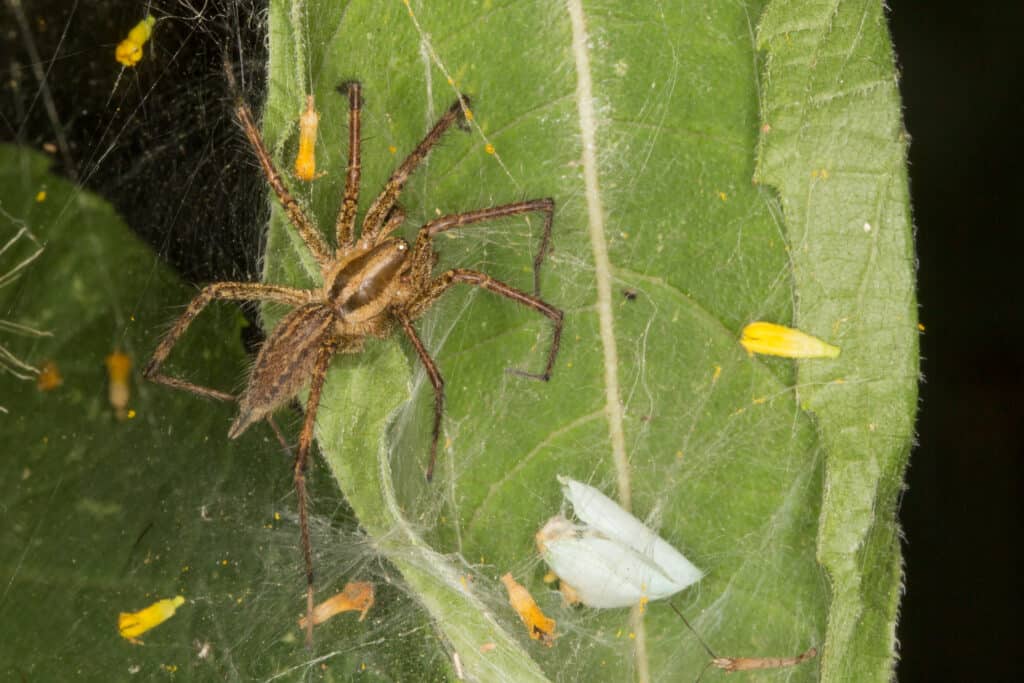
The plentiful American grass spider is one of the most common spiders across the United States.
©Elliotte Rusty Harold/Shutterstock.com
Appearance: They are greyish-brown with dark stripes on either side of their head and down their abdomen.
Size: 1/4 – 1/2 inch long with a leg span of 1 – 1.5 inches
Diet: Mosquitos, gnats, flies, and anything else that walks on their sheet web.
Habitat: Found in sheet-like webs with funnels in the grass. They sometimes make a small nest with a funnel between fences or other protected outdoor locations.
Behavior: They are extreme and very fast hunters who wait for their prey to step onto their flat web before rushing out of their funnel and grabbing them.
17. Yellow Garden Spider (Argiope aurantia)
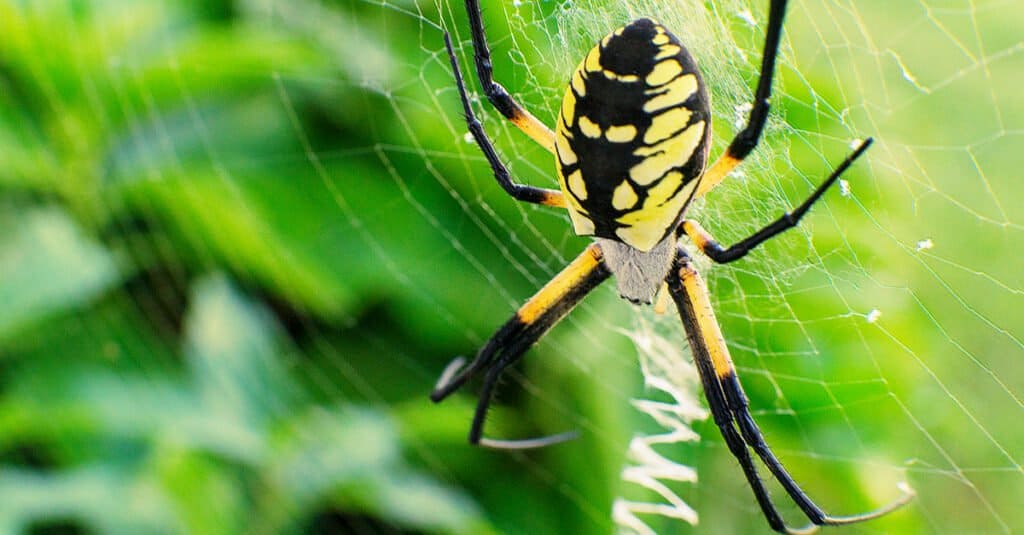
Yellow garden spiders are beneficial for pest control, and they make beautiful webs.
©Theodore P. Webb/Shutterstock.com
Appearance: Lovely, large, yellow, and black spiders with long, grey heads and very long, delicate, spindly, black legs.
Size: The females’ body can reach almost 2 inches long, and their leg span can reach between 3 – 4 inches.
Diet: They will eat anything that lands on their webs, such as cicadas, moths, bees, butterflies, mosquitos, and flies.
Habitat: These spiders make 1 – 3 foot webs on the edge of forests and anywhere that has bush or tree space on the edge of a wooded area.
Behavior: Very calm, almost blind spiders who appear in late summer and disappear once they have laid eggs.
FAQ
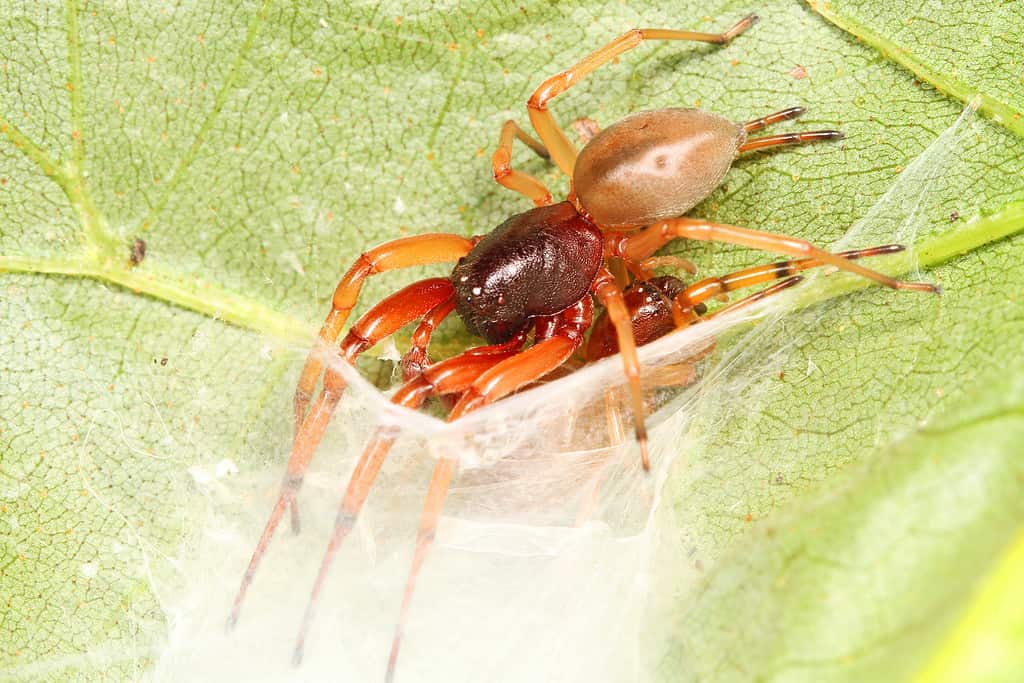
Much is still a mystery when it comes to arachnids.
© – License
Q: What is the most common spider in Chicago?
A: The common house spider is abundant in the city and lives in many of the homes and businesses. It is not aggressive and can be unknown to the residents of the building. They are excellent guests in any building because they hunt for pests that come in, including mosquitos, fruit flies, and other spiders.
Q: Does Chicago have a bug problem?
A: In 2023, Chicago ranked first for bed bug issues in the country. Also, this news came right after Orkin crowned Chicago the rat capital of the world for the eighth year in a row. So, yes, Chicago has a bug problem and a rat problem.
Q: Are black widows common in Chicago?
A: It is rare to see a black widow in Chicago, but not unheard of. They are very reclusive spiders and hide for their entire lives. Since they are black and nocturnal, it’s also next to impossible to see them in the dark. It’s advised not to go searching for anything in your dark garage or attic at night, they hide in places exactly like that, and if you threaten to hurt them (sticking your hand in a box and grabbing them), they will bite. Otherwise, they will not bite but will try to hide.
The photo featured at the top of this post is © iStock.com/earlydawnphotography
Thank you for reading! Have some feedback for us? Contact the AZ Animals editorial team.



